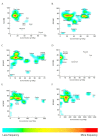Virgin Olive Oil Ranks First in a New Nutritional Quality Score Due to Its Compositional Profile
- PMID: 37432257
- PMCID: PMC10180740
- DOI: 10.3390/nu15092127
Virgin Olive Oil Ranks First in a New Nutritional Quality Score Due to Its Compositional Profile
Abstract
Dietary oils play a crucial role in maintaining a healthy diet. However, with the increasing number of oils available, it became a challenging task for food producers and consumers to select the best oil for their needs. In this work, an easy-to-understand nutrition quality score was created, using a model that included beneficial lipid compounds criteria according to the dietary recommendations published by international food and health organizations. The algorithm assigned points for each component of the model considering their content in each particular oil. The points were added up and the fats and oils were classified by the corresponding percentile. As a result, among the 32 edible oils that were evaluated, virgin olive oil ranked first with a score of 100. All plant oils, except for margarine and coconut oil, ranked above the 50th percentile. Receiver-operator curves and regression models showed that saturated fatty acids may be able to predict the score, and thus, the nutritional quality of the oils. In conclusion, the proposed nutritional quality score would promote healthy and nutritious food options for consumers and would provide food producers with a valuable tool to select high-quality oils for their products, ensuring that they meet the nutritional requirements.
Keywords: bioactive compounds; fat; fatty acids; nutrients; nutritional quality; oil; score.
Conflict of interest statement
The authors declare no conflict of interest.
Figures


Similar articles
-
Butter, Margarine, Vegetable Oils, and Olive Oil in the Average Polish Diet.Nutrients. 2019 Dec 3;11(12):2935. doi: 10.3390/nu11122935. Nutrients. 2019. PMID: 31816944 Free PMC article.
-
Studying the Evaluation Model of the Nutritional Quality of Edible Vegetable Oil Based on Dietary Nutrient Reference Intake.ACS Omega. 2021 Mar 5;6(10):6691-6698. doi: 10.1021/acsomega.0c05544. eCollection 2021 Mar 16. ACS Omega. 2021. PMID: 33748582 Free PMC article.
-
Virgin olive and fish oils enhance the hepatic antioxidant defence system in atherosclerotic rabbits.Clin Nutr. 2003 Aug;22(4):379-84. doi: 10.1016/s0261-5614(03)00038-4. Clin Nutr. 2003. PMID: 12880605
-
Tropical oils: nutritional and scientific issues.Crit Rev Food Sci Nutr. 1992;31(1-2):79-102. doi: 10.1080/10408399209527562. Crit Rev Food Sci Nutr. 1992. PMID: 1345319 Review.
-
Virgin olive oil: a key food for cardiovascular risk protection.Br J Nutr. 2015 Apr;113 Suppl 2:S19-28. doi: 10.1017/S0007114515000136. Br J Nutr. 2015. PMID: 26148918 Review.
Cited by
-
Oleogel Systems for Chocolate Production: A Systematic Review.Gels. 2024 Aug 29;10(9):561. doi: 10.3390/gels10090561. Gels. 2024. PMID: 39330164 Free PMC article. Review.
-
Exploring the impact of lipid stress on sperm cytoskeleton: insights and prospects.Nat Rev Urol. 2025 May;22(5):294-312. doi: 10.1038/s41585-024-00952-1. Epub 2024 Nov 11. Nat Rev Urol. 2025. PMID: 39528754 Review.
-
Chemical Data and Relationships for a Scoring Algorithm of Extra Virgin Olive Oil's Nutritional Value.Molecules. 2024 Jan 21;29(2):525. doi: 10.3390/molecules29020525. Molecules. 2024. PMID: 38276603 Free PMC article.
-
Enhanced Labeling to Promote Consumption of Nutrient Dense Foods and Healthier Diets.Foods. 2024 Oct 24;13(21):3377. doi: 10.3390/foods13213377. Foods. 2024. PMID: 39517161 Free PMC article.
-
Vegetable Oils and Their Use for Frying: A Review of Their Compositional Differences and Degradation.Foods. 2024 Dec 23;13(24):4186. doi: 10.3390/foods13244186. Foods. 2024. PMID: 39767128 Free PMC article. Review.
References
-
- Jinadasa B.K.K.K., Van Bockstaele F., Cvejic J.H., Simal-Gandara J. Future Foods. Academic Press; Cambridge, MA, USA: 2022. Current trends and next generation of future edible oils; pp. 203–231. - DOI
-
- AOCS . Official Methods and Recommended Practices of the American Oil Chemist Society. 6th ed. AOCS; Urbana, IL, USA: 2012.
-
- FAO/WHO Fats and fatty acids in human nutrition. Report of an expert consultation. FAO Food Nutr. Pap. 2010;91:1–166. - PubMed
MeSH terms
Substances
LinkOut - more resources
Full Text Sources
Research Materials

